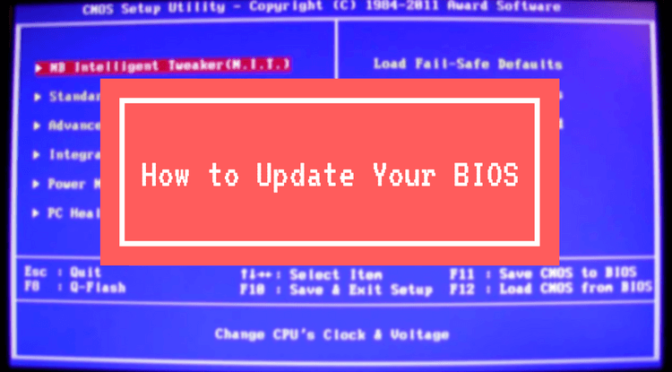A little BIOS chip covers up inside every PC, sitting on your motherboard to restore your system when you press the power button. It controls your PC, anyway guarantees it, also as Duo Security’s progressing report on Apple Mac OS ambushes points out.
BIOS refers to the basic input and output system and the BIOS chip instates the different segments in your PC, incorporates CPU, GPU, and motherboard chipset. But a couple of years earlier, motherboard producers in relationship with Microsoft and Intel introduced a trade for ordinary BIOS chips named UEFI (Unified Extensible Firmware Interface).
Essentially every motherboard conveying today has a UEFI chip rather than a BIOS chip, anyway, the two offer a comparative core reason: setting up the structure to boot into the working framework. Still, most of the people call UEFI the BIOS because of various similarities in them.
Reasons to update your BIOS
Understanding your UEFI is noteworthy so you can perceive how and if to advantage of the segment updates and bug fixes that go with the BIOS updates offered by motherboard makers.
Your computer’s motherboard generally uses whatever given firmware modification the motherboard creator was on back when it was built. Over the future of a motherboard, makers discharge new firmware packs or BIOS updates that will engage support for new processors and memory or fathom typically reported bugs. For a seriously long time, the fundamental veritable inspiration to revive to a more updated firmware alteration is to fathom a bug in your UEFI or to trade in a CPU that is more state of the art than your motherboard.
Most of the people like to regularly check for and update their UEFI firmware packages just to keep up to date. On the double, this was seen as a risky practice, given that the firmware refreshing technique can obstruct your motherboard also that glimmering a custom ROM on to Android telephone can block the gadget. It is best not to refresh your UEFI firmware except for if there is something express that the refreshed firmware offers that you need.
Taking everything into account, you likely need to keep consistent over BIOS update if you’re on a chip or motherboard stage that is as of late out of the entryways. Most of the motherboard BIOS updates were discharged over the essential week that AMD’s problematic new Ryzen chips were in experts’ grasp, and each gave additional execution and structure framework steadiness. Expect for those to proceed as AMD works the bugs out of Ryzen.
Steps to update computer BIOS
- Current BIOS version: Before you update your BIOS, guarantee you’re truly installing in a new version. The most direct way to deal with finding your BIOS variant is to open up the System Information application by forming MS info into the Windows search bar. The window which will open, shows the BIOS variation on the right side, under your processor speed. Record your variation number and date, by then differentiate it to the latest version available on your motherboard’s assistance page on the maker’s site.
- Enter UEFI BIOS: Then to boot up your PC and you will see a text that instructs you which button to press to enter the UEFI BIOS. Then press that button (The particular button required, and the arrangement of each motherboard’s genuine UEFI control board differs, so these rules will be a greater number of guideposts than a little bit at a time bearings.)
- Boot UEFI control board (at whatever point the circumstance permits): Not every motherboard offer this part, on explicit models you can boot into the UEFI control board and use an innate update utility to interface with the web and glimmer the latest firmware from the maker’s server. This charming segment makes invigorating to additional exceptional firmware alterations as simple as could be normal in light of the current situation. The system is progressively required for motherboards that don’t underpin this segment.
- Find the latest BIOS update from your motherboard’s assistance/bolster page: Go to your motherboard’s assistance page on the website. The latest BIOS update should be in the assistance and downloads fragment.
- Download and unfasten the BIOS update document in your framework.
- Move update document into a USB flash drive.
- Reboot your computer into the UEFI control board.
- Dispatch the UEFI’s firmware update instrument and back up your PC’s present firmware to your flash drive: This guarantees you if something turns out severely.
- Use the proportional UEFI utility to pick the new firmware picture you saved money on the blaze drive: Running the firmware update utility should take only a few minutes, yet take the necessary steps not to close off your PC during this system.
- At the point when the flashing methodology finishes, restart your PC: Your refreshed PC BIOS is set up to shake.
A couple of creators offer utilities that can refresh your UEFI chip from inside Windows by running a .exe document, anyway we recommend using one of the two techniques above to sidestep any issues.
Again, updating your PC’s BIOS can give various points of interest, anyway, it’s basic to fathom the perils. Make an effort not to get in touch with it if there is unquestionably not an indisputable, persuading inspiration to revive your UEFI firmware. Taking everything into account, if you have to drop in a progressively current CPU into an increasingly settled motherboard, by then doubtlessly a BIOS update lies in your future.
We ascertain that our proficiency in dealing with Motherboard Repair in Brisbane is going to save your day. We cater to motherboard repair for your PCs and laptop with a limited warranty on the replacement of all parts. To know more contact us and visit our site.
Call us at 0420268712 | Email: info@yorit.com.au
Read More
 CART - $
0.00
CART - $
0.00 

